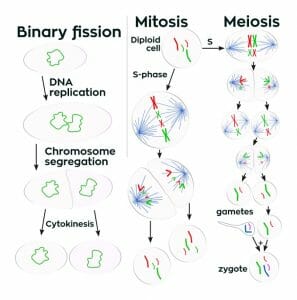Cell division has three main functions which are reproduction of unicellular organisms and the production of gametes and growth in eukaryotes. The process of meiosis in eukaryotes produces sex cells or gametes with half the chromosome compliment of somatic cells. Multicellular eukaryotic organisms use mitosis to grow and to repair their tissues. In contrast, prokaryotes (single-celled organisms) reproduce using a process similar to mitosis called binary fission. In binary fission, the organism divides to create an exact copy of itself, also called a clone.

The image above shows the three types of cell division. Binary fission is used for reproduction by single-celled organisms, mitosis is used for the growth and maintenance of eukaryotic organisms and the process of meiosis produces eggs and sperm in eukaryotes.
References
- Cell Division. (n.d.). In Encyclopedia.com. Retrieved from http://www.encyclopedia.com/science-and-technology/biology-and-genetics/cell-biology/cell-division
Purpose of Cell Division
No comments:
Post a Comment